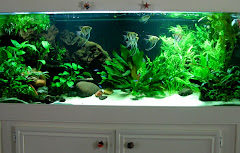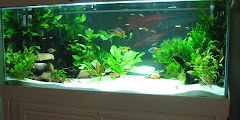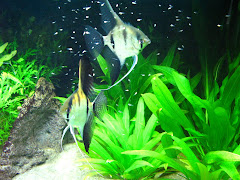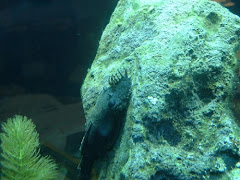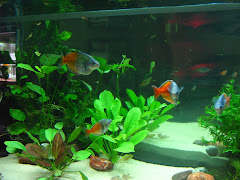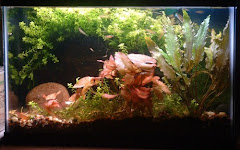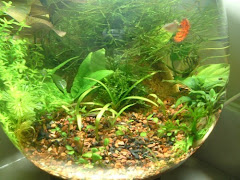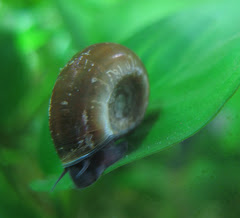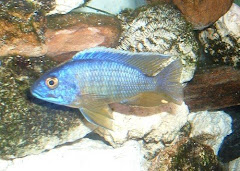skip to main |
skip to sidebar
 Nothing new to report - the tank is experiencing a nice nitrite spike, and in the presence of nitrate that means we won't have much of a wait. The goldfish are happy and look healthier than ever, with careful PWCs and a LOT of water for them.
Nothing new to report - the tank is experiencing a nice nitrite spike, and in the presence of nitrate that means we won't have much of a wait. The goldfish are happy and look healthier than ever, with careful PWCs and a LOT of water for them.
Many, many people disagree with using fish to cycle a tank, and woe unto you if you dare discuss doing this on an aquarium forum!! (Go ahead.... I dare you! :)).
There are many species of fish that cannot tolerate this process, but there are several that do. I have used ammonia to cycle a tank, the rotting shrimp method, fish food with no fish method, etc., and in a small tank frankly I would not use fish to cycle it unless they were extremely small ones (like Endler's or very small guppies) - it is close quarters and the effects of ammonia and nitrate are quite stressful to the hardiest of species. I have enough tanks running that I could start a decent sized tank with filthy filter media from my other tanks, but I don't have enough to get a 150-gallon started, and I have found, in this particularly large tank, that hardy fish tolerate the cycle.
So we will sit back and wait. This last part of the cycle can linger on and on for weeks, so patience is tested at this stage. Patience is not one of my strongest traits (!!) but there is no way I am going to put an expensive Tanganyikan in this tank until the water is very stable. They are extremely sensitive. When I was keeping calvus (one of my favorite tanks setups) even though I took care to keep the water change water as close as humanly possible to the tank water, with once weekly changes on a strict schedule, the fish would lie down on their sides on the sand every time I changed the water. Obviously there was some parameter that did not match, and the slightest thing sent them into dramatic exclamations. This did not seem to have any long-term deleterious effect on the fish, but I always felt horrible. I did not have this happen with N. brichardi/pulcher or with N. leleupi.
At any rate, the goldfish are showing no fin damage, no change in activity (can't get a decent still shot of them ever) and are eating like pigs so I'll soldier on. They look pretty cool in this tank, and I try to imagine what it would look like if they were much larger in this same tank (it would look COOL) but that is a tank for another time. This one is slated for Africans, specifically deep water Lake Tanganyika Africans, so I look forward to the day in the coming weeks when I can proudly post pics of my shiny new black and white with blue striped baby frontosa. Or Kodak box yellow leleupi. Or golden-headed compressiceps... spotted calvus... Ahhhhhh.....
 Here are some goldfish in the new setup until I decide what to do about the Africans. The pH is very nice and steady at 8.1, compared to 7.4 out of the tap. This is completely the result of the aragonite sand. I'm going to leave the goldies in residence for a couple of weeks and then order my frontosa.
Here are some goldfish in the new setup until I decide what to do about the Africans. The pH is very nice and steady at 8.1, compared to 7.4 out of the tap. This is completely the result of the aragonite sand. I'm going to leave the goldies in residence for a couple of weeks and then order my frontosa.
I'm reading more and more about them and it seems that the best bet is to have no tankmates - they can be either nippy and damage the trailing fins, stressing the fronts, or they will be too small and become meals for the fronts.
I think I might try a colony of N. leleupi, some of my favorite Lake Tang species, and see how it goes, especially while the fronts are small.

I redid the rocks, again. I think if I'm not soaked to the armpit and pruny then I just don't feel like it has been a good day.
I scared up a few much larger stones to complement my plethora of small ones. I spent several hours stacking, restacking, adjusting, adding, removing, and scratching my chin and squinting at the tank.
Now I am happier with how it looks, though a rock background would really make me happy. That, however, is for another day. I will let the tank run for a while, but possibly I'll add some black mollies to see how things go. I have cycled this large tank with fish before, since the ammonia and nitrite are so diluted that the fish do not seem to stress or suffer, it seems.
I do not want to spend $$$ to ship delicate species (seems like Lake Tang fish are much more sensitive than other cichlid species, and thereby are always more expensive) and have them all keel over after being added to the tank. I need to put some inexpensive fish in there to ease my mind that all is well. The problem is that I will then need to remove said "test" fish and that might be quite a trick. Maybe I'll use the goldfish in my 37g and be sure they do okay, and they are easy enough to net out as they come bobbling over to see what that net thing is all about. I'll sit tight for now.
 Here is a pic of where the P. leopoldi now reside, though it is too small for them all and I'll need to split up the group in the near future. I like this tank, in spite of my previous comments about all my tanks being overplanted with no room for fish. This is a 40-gallon breeder and was the quarantine tank for these leopoldi when I got them.
Here is a pic of where the P. leopoldi now reside, though it is too small for them all and I'll need to split up the group in the near future. I like this tank, in spite of my previous comments about all my tanks being overplanted with no room for fish. This is a 40-gallon breeder and was the quarantine tank for these leopoldi when I got them.
Het rasboras and ember tetras are in residence as well as a balloon ram. I'm not proud to own such a fish (I'll admit I'm a snob and prefer my aquarium fish to be close to what is found in the wild - long-finned this, albino that do not appeal to me typically), but she was very pretty and I've never had luck keeping rams and hoped I could do it this time. I lost the male but she's been holding her own for quite a while now.
There is also one domestic silver/wild type in with the leopoldi and you can hardly tell him apart from them, except he has red eyes, leopoldi do not, and his nose has a bit of an upturn, whereas theirs is turned down a bit.
The 150 is emptied and reconfigured. I had quite an adventure in the process. Netting out each species for relocation to various locales, arranging meetings with other hobbyists and even turning in unwanted individuals for credit at the LFS, all accomplished in a day. Then I had to deal with the play sand. I highly recommend regular play sand for most any tank - it is very fine and soft so appropriate for the delicate barbels of catfish.
Aside: This is a very important aspect to keeping cories, in particular, and one that is very often overlooked! If you have cory cats in a tank with gravel, you will likely find the cories have a shorter lifespan, unless you observe meticulous maintenance habits. These fish sift through sand in the wild and they will very much appreciate sand in their habitat. There are many aquarium sands that are sharp and can damage barbels, so choose carefully. Play sand is one that works very, very well. *EDIT: Be aware that this is my own personal opinion. I can't say, truly, what cories "like" best, but I prefer to use sand for them, and soft sand that is not sharp.*
Back to the story! Why, you ask, do I not simply keep the play sand for my Africans? Well, originally I had planned black sand substrate, so I intended to remove every speck of play sand. Somewhere along the line when I bailed on my background project and realized I would have a solid black background and dark rocks, I decided black sand would be overkill and white sand would be preferable. Since my rocks are river rocks and are not calciferous limestone (like I was planning at one time) I decided to use aragonite sand, which is a buffering substrate, and will help me maintain a pH closer to 8.
I recognize that the fish I will likely keep have been tank bred in the US and may never have seen water as alkaline as their wild cousins in Lake Tanganyika, but it is easy enough to use a buffering sand and give the alkalinity a boost. Couldn't hurt. I do not have plans to go to great efforts to buffer my water at this point. The other benefit is that the aragonite sand I purchased (CaribSea) is white white white, and offers a very nice contrast.
Ok. Here's how it went. The tank was emptied and cleaned out.

 The filters were also cleaned down to new floss and completely scrubbed out to eradicate the MTS infestation, and replaced under the tank. Heavy job! On the left is the Rena Filstar XP4, and on the right is the Fluval FX5. On the far left is my CO2 tank and regulator, which is parked in storage there for now, as I won't be using it on this tank in the near future. I am keeping the pH monitor running, as that is handy.
The filters were also cleaned down to new floss and completely scrubbed out to eradicate the MTS infestation, and replaced under the tank. Heavy job! On the left is the Rena Filstar XP4, and on the right is the Fluval FX5. On the far left is my CO2 tank and regulator, which is parked in storage there for now, as I won't be using it on this tank in the near future. I am keeping the pH monitor running, as that is handy.

I used the overflow box from when the tank was drilled to hide my large and unsightly filter intakes. If you look closely in the center of this photo you can barely make out the horizontal slits cut into the overflow box. The vertical PVC pipe is the strainer for the drain in the bottom of the tank, which came in VERY handy during the emptying and cleaning of this tank. At the beginning of this blog you can see how this was configured, with a hose bib on the outside of the stand. I connect a garden hose to that and turn the hose valve to drain the tank out the door, and I used another garden hose connected to the outdoor faucet and washed out the tank, with the water going down the drain. Love that. The overflow box is not siliconed in place, but stands quite firmly in place with tiny gaps next to the glass to allow better water flow. I may wind up adding more slits to this box to increase flow to the intakes, but we will see how the filtration looks. I have quite a bit of flow in this tank and don't think the box gets in the way too much. It is very effective at hiding the intakes, and it blends right in with the black external background.
Here's where I started stacking rocks and adding sand.
 The sand was just a bit problematic. I read up on it and decided not to rinse it first, since I wanted to keep all of the buffering properties. Everyone says how it "clears up in a few hours...." It didn't. I had to drain and refill and rinse the sand in the tank after all. This is not much of a problem, though, with my drain hose as described above.
The sand was just a bit problematic. I read up on it and decided not to rinse it first, since I wanted to keep all of the buffering properties. Everyone says how it "clears up in a few hours...." It didn't. I had to drain and refill and rinse the sand in the tank after all. This is not much of a problem, though, with my drain hose as described above.
 Cloudy. Hmm. Better drain and fill one more time. This time I'll use the Python and fill it from the sink as well as use a garden hose from outside to make things move along more quickly. Oops.
Cloudy. Hmm. Better drain and fill one more time. This time I'll use the Python and fill it from the sink as well as use a garden hose from outside to make things move along more quickly. Oops.
 Oh well - no worries! We have technology to suck water off the floor! *Ahem*
Anyway, I kept at it and finally it started clearing, and I started playing with rocks. I have to say I'm not entirely happy with these rocks, as they are too small and it makes the tank look cluttered in spite of the spare decor.
Oh well - no worries! We have technology to suck water off the floor! *Ahem*
Anyway, I kept at it and finally it started clearing, and I started playing with rocks. I have to say I'm not entirely happy with these rocks, as they are too small and it makes the tank look cluttered in spite of the spare decor. I redid it several times. And redid it several more times.... I had to stop because the wet arm and sopping shirt gets annoying after a while.
I redid it several times. And redid it several more times.... I had to stop because the wet arm and sopping shirt gets annoying after a while.
OH! I forgot about the lighting! I'm very pleased with that. I used "puck" lights from an under cabinet fixture. Each puck is daisy-chained together so you can add or remove a fixture as necessary. The fixture I have came with 4 pucks, each connected with a removable wire about 12" long. I installed them randomly in the hood. Each puck is about 3" in diameter and has I don't know how many individual LED lights.
Here is a shot of the lights. I have since taken out all but two of them (this tank needs to be relatively dim), though the fixtures are still there. The frame is screwed in and connected by the wires, but the actual light component can be unscrewed and removed, without the other pucks going out. Love this fixture, and it was under $20, unlike the LED fixtures made for aquariums ($$$$). I will install a small fan under the hood to reduce humidity that will no doubt damage this fixture.

I finally got the water to clear up after 4 days. Again, I'm not entirely happy with this tank at this point. I wish I had a DIY internal background, either some sort of real rock veneer or a carved styrofoam background coated in concrete and painted to look like rock, but I did not have the energy to deal with the styrofoam method and I could not find thin rocks that would 1) not be too heavy, 2) not break the bank, and 3) not look contrived or too deliberate. I don't really like the rock decor but they are growing on me.
I will put a trio of N. leleupi in there to start things off. Their bright yellow is going to show up very well in this tank, and they will love the rocks.
A word about the rationale behind how this tank is being 'scaped: C. frontosa are deep water Lake Tanganyikan fish and are accustomed to dim conditions. Again, I realize the fish I'll likely get have never seen the lake, and may have spent their entire fry-hood under fluoro lights, but I do think they will feel more comfortable in conditions closer to that of the lake. If you look on You Tube for Lake Tanganyika videos you will see what I mean. There are rocks and sand and that's pretty much it. Few plants, and certainly no driftwood and flower pots, lol.
I have kept aquariums for nearly 30 years now and as I've matured I've been leaning towards natural looking aquascapes, with lots of plants and wood and rocks and such, which is pretty, but it is one of the reasons I took down the 150 - I'm tired of the fussiness and overcrowded way I tend to keep aquariums: lots of lush plants layered together with artfully arranged driftwood and rocks, and hardly room for the fish. It is pretty but I yearn for a minimalist tank that is simple and clean. This will certainly be that! More later.















